Geophagia
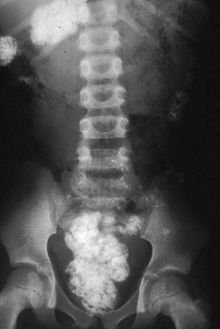
Geophagia(/ˌdʒiːəˈfeɪdʒ(i)ə/), also known asgeophagy(/dʒiˈɒfədʒi/),[1]is the intentional[2]practice of eating earth or soil-like substances such asclay,chalk,or termite mounds. It is a behavioural adaptation that occurs in many non-human animals and has been documented in more than 100 primate species.[3]Geophagy in non-human primates is primarily used for protection from parasites, to provide mineral supplements and to help metabolize toxic compounds from leaves.[4]Geophagy also occurs in humans and is most commonly reported among children and pregnant women.[5]
Human geophagia is a form ofpica– the craving and purposive consumption of non-food items – and is classified as an eating disorder in theDiagnostic and Statistical Manual of Mental Disorders(DSM) if not socially or culturally appropriate.[6]Sometimes geophagy is a consequence of carrying ahookworm infection.Although itsetiologyremains unknown, geophagy has many potential adaptive health benefits as well as negative consequences.[5][7]
Animals[edit]
Geophagia is widespread in the animal kingdom.Galen,the Greek philosopher and physician, was the first to record the use of clay by sick or injured animals in the second century AD. This type of geophagia has been documented in "many species of mammals, birds, reptiles, butterflies and isopods, especially among herbivores".[8]
Birds[edit]
Many species of South American parrots have been observed atclay licks,andsulphur-crested cockatooshave been observed ingesting clays inPapua New Guinea.Analysis of soils consumed by wild birds show that they often prefer soils with high clay content, usually with thesmectiteclay families being well represented.[9]
The preference for certain types of clay or soil can lead to unusual feeding behaviour. For example, Peruvian Amazon rainforest parrots congregate not just at one particular bend of theManu Riverbut at one specific layer of soil which runs hundreds of metres horizontally along that bend. The parrots avoid eating the substrate in layers one metre above or below the preferred layer. These parrots regularly eat seeds and unripe fruits containing alkaloids and other toxins that render the seeds and fruits bitter and even lethal. Because many of these chemicals become positively charged in the acidic stomach, they bind to clay minerals which have negatively chargedcation-exchangesites, and are thereby rendered safe. Their preferred soils have a much higher cation-exchange capacity than the adjacent, rejected layers of soils because they are rich in the mineralssmectite,kaolin,andmica.The preferred soils surpass the pure mineral kaolinate and surpass or approach purebentonitein their capacity to bind quinine and tannic acid.[8]
In vitroandin vivotests of these soils and many others from southeastern Peru indicate that they also release nutritionally important quantities of minerals such ascalciumandsodium.In the Manu River example cited above, the preferred soil bands had much higher levels of sodium than those that were not chosen. Repeated studies have shown that the soils consumed most commonly by parrots in South America have higher sodium contents than those that are not consumed.[10][11][12]
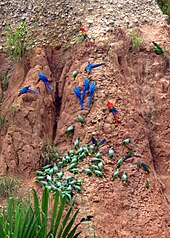

It is unclear which factor is driving avian geophagy.[13]However, evidence is mounting that sodium is the most important driver among parrots in southeastern Peru. Parrots are known to eat toxic foods globally, but geophagy is concentrated in very specific regions.[14]Researchers Lee etal. show that parrot geophagy in South America is positively correlated to a significant degree with distance from the ocean. This suggests that overall lack of sodium in the ecosystem, not variation in food toxicity, is a better predictor of the spatial distribution of geophagy. This work, coupled with the recent findings of consistently high sodium levels in consumed soils,[10][11][12]make it highly likely that sodium is the primary driver of avian geophagy among parrots (and possibly other taxa) in the western Amazon Basin. This supplemental nutrients hypothesis is further supported by peak geophagy occurring during the parrots' breeding season.[15]
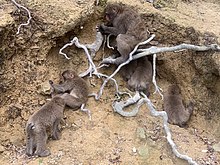
Primates[edit]
There are several hypotheses about the importance of geophagia in bats and primates.[16]: 436 [17]ChimpanzeesinKibale National Park,Uganda,have been observed to consume soil rich inkaoliniteclay shortly before or after consuming plants includingTrichilia rubescens,which possessesantimalarialproperties in the laboratory.[18]
Geophagy is a behavioural adaptation seen in 136 species of nonhuman primates from the suborder Haplorrhini (81%) and Strepsirrhini (19%).[19]The most commonly ingested soils are soils from mounds, soils from tree bases, soils from termite mounds, 'Pong' soils, forest floor.[4]Studies have shown many benefits of geophagy such as protection from parasites (4.9%), minerals supplements (19.5%) and helps metabolize toxic compounds from leaves (12.2%) nonexclusive.[4]From soil analysis it has been seen that one of the main compounds in the earth consumed by these primates is clay minerals that contains kaolinite which is commonly used in medications for diarrheal and intestinal problems.[20]Geophagic behaviour plays an important role in nonhuman primates health.[4]This kind of zoopharmacognosy use differs from one species to another. For example, Mountain Gorillas from Rwanda tend to ingest clay soil during dry season, when the vegetation changes forcing them to feed on plants that have more toxic compounds, in this case the ingested clay absorbs these toxins providing digestive benefits.[4]This kind of seasonal behavioural adaptation is also seen in the Red-Handed Howler monkeys from the western Brazilian Amazonia, which also have to adapt to the shift of feeding on leaves that contains more toxic compounds.[21]In other cases, geophagy is used by the Ring-Tailed Lemurs as a preventive and therapeutic behaviour for parasites control and intestinal infection.[19]These benefits from clay ingestion can also be observed among Rhesus Macaques.[20]In a study that was carried out in the Island of Cayo Santiago, it has been observed that the Rhesus Macaques had intestinal parasites and their health was not affected and they did not have many gastrointestinal effects from these parasites.[20]Data observed, shows that this was caused by the consumption of clay soil by this species.[20]On the other hand observations have shown that behavioural geophagy provides minerals supplements, as seen among Cambodian's Colobinae.[22]The study was done at the salt licks in Veun Sai-Siem Pang Conservation Area, a site that is visited by various species of nonhuman primates.[22]More in-depth research needs to be carried out in order to better understand this behavioural adaptation of geaophagy among nonhuman primates.
Bats[edit]
There is debate over whether geophagia in bats is primarily for nutritional supplementation or detoxification. It is known that some species of bats regularly visitmineral or salt licksto increase mineral consumption. However, Voigt etal. demonstrated that both mineral-deficient and healthy bats visit salt licks at the same rate.[23]Therefore, mineral supplementation is unlikely to be the primary reason for geophagia in bats. Additionally, bat presence at salt licks increases during periods of high energy demand.[23]Voigt etal. concluded that the primary purpose for bat presence at salt licks is for detoxification purposes, compensating for the increased consumption of toxic fruit and seeds.[23]
Humans[edit]
Anthropological and historical evidence[edit]
Evidence for the likely origin of geophagy was found in the remains of early humans in Africa:
The oldest evidence of geophagy practised by humans comes from the prehistoric site atKalambo Fallson the border betweenZambiaandTanzania(Root-Bernstein& Root-Bernstein, 2000). Here, a calcium-rich white clay was found alongside the bones ofHomo habilis(the immediate predecessor ofHomo sapiens).
— Peter Abrahams,Geophagy and the Involuntary Ingestion of Soil[16]: 446

Geophagia is nearly universal around the world in tribal and traditional rural societies (although apparently it has not been documented in Japan or Korea).[16]In theancient world,several writers noted the phenomenon of geophagia.Plinyis said to have noted the ingestion of soil onLemnos,an island of Greece, and the use of the soils from this island was noted until the 14th century.[16][24]The textbook ofHippocrates(460–377 BCE) mentions geophagia, and the famous medical textbook titledDe Medicinaedited byA.Cornelius Celsus(14–37 CE) seems to link anaemia to geophagia.[24]One ofRumi's fables tells about a geophage being cheated by a sugar seller who leaves him alone with a weight made of clay and then waits until the man eats enough of it, thus reducing the amount of sugar he will get.[25]
The existence of geophagy among Native Americans was noted by early explorers in the Americas, includingGabriel Soares de Sousa,who in 1587 reported a tribe in Brazil using it in suicide,[16]andAlexander von Humboldt,who said that a tribe called the Otomacs ate large amounts of soil.[24]In Africa,David Livingstonewrote about slaves eating soil in Zanzibar,[24]and it is also thought that large numbers of slaves brought with them soil-eating practices when they were trafficked to theNew Worldas part of the transatlantic slave trade.[16]Slaves who practised geophagia were nicknamed "clay-eaters" because they were known to consume clay, as well as spices, ash, chalk, grass, plaster, paint, and starch.[26]
Contemporary practices[edit]
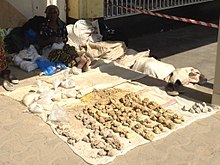
InAfrica,kaolinite,sometimes known askalaba(inGabon[27]andCameroon),[28]calaba,andcalabachop(inEquatorial Guinea), is eaten for pleasure or to suppress hunger.[28]Kaolin for human consumption is sold at mostmarketsin Cameroon and is often flavoured with spices such asblack pepperandcardamom.[29]Consumption is greatest among women, especially to cure nausea during pregnancy, in spite of the possible dangerous levels ofarsenicandleadto the unborn child.[30][31]Another example of geophagia was reported in Mangaung,Free State ProvinceinSouth Africa,where the practice was geochemically investigated.[32]Calabash chalkis also eaten in west Africa.[33]
InHaiti,poor people are known to eatbonbon tèmade from soil, salt, and vegetable shortening. These biscuits hold minimal nutritional value, but manage to keep the poor alive.[34]However, long-term consumption of the biscuits is reported to cause stomach pains and malnutrition, and is not recommended by doctors.[35]
InCentral JavaandEast Java,Indonesiaa food made ofsoilcalledampois eaten as a snack or light meal.[36][37][38]It consists of pure clay, without any mixture of ingredients.[36]
Bentonite clayis available worldwide as a digestive aid;kaolinis also widely used as a digestive aid and as the base for some medicines.Attapulgite,another type of clay, is an active ingredient in many anti-diarrheal medicines.[26]
Impact on health[edit]
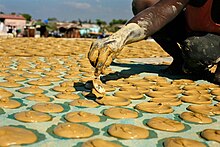
Clay minerals have been reported to have beneficial microbiological effects, such as protecting the stomach against toxins, parasites, and pathogens.[39][40]Humans are not able to synthesizevitamin B12(cobalamin), so geophagia may be a behavioral adaption to obtain it from bacteria in the soil.[41]Mineral content in soils may vary by region, but many contain high levels ofcalcium,copper,magnesium,iron,andzinc,minerals that are critical for developing fetuses which can cause metallic, soil, or chewing ice cravings in pregnant women. To the extent that these cravings, and subsequent mineral consumption (as well as in the case of cravings for ice, or other cold neckvasoconstrictingfood which aid in increasing brain oxygen levels by restricting neck veins) are therapeutically effective decreasing infant mortality, those genetic predispositions and the associated environmental triggers, are likely to be found in the infant as well. Likewise, multigenerationally impoverished villages or other homogenous socioeconomic closed genetic communities are more likely to have rewarded gene expression of soil or clay consumption cravings, by increasing the likelihood of survival through multiple pregnancies for both sexes.[40][42]
There are obvious health risks in the consumption of soil that is contaminated by animal or humanfeces;in particular,helmintheggs, such asAscaris,which can stay viable in the soil for years, can lead tohelminth infections.[43][44]Tetanusposes a further risk.[43]Lead poisoningis also associated with soil ingestion,[45]as well as health risks associated withzinc exposurecan be problematic among people who eat soils on a regular basis.[32]Gestational geophagia (geophagia in pregnancy) has been associated with various homeostatic disruptions and oxidative damage in rats.[46]
See also[edit]
- Ampo (snack)
- Medicinal clay,a variety of clays chosen and used for medicinal purposes, including through consumption
References[edit]
- ^Ziegler, J. (1997)."Geophagia: a vestige of paleonutrition?".Tropical Medicine and International Health.2(7): 609–611.doi:10.1046/j.1365-3156.1997.d01-359.x.PMID9270727.S2CID71822543.
- ^Fack, Vinciane; Shanee, Sam; Vercauteren Drubbel, Régine; Vercauteren, Martine; Meunier, Hélène (May 2020). "Geophagy in the yellow-tailed woolly monkey (Lagothrix flavicauda) at La Esperanza, Peru: site characterization and soil composition".Primates.61(3): 507–518.doi:10.1007/s10329-020-00802-9.PMID32095910.S2CID211253699.
- ^Pebsworth, Paula A.; Huffman, Michael A.; Lambert, Joanna E.; Young, Sera L. (January 2019)."Geophagy among nonhuman primates: A systematic review of current knowledge and suggestions for future directions".American Journal of Physical Anthropology.168(S67): 164–194.doi:10.1002/ajpa.23724.PMID30508222.
- ^abcdeKrishnamani, R.; Mahaney, William C. (2000-05-01). "Geophagy among primates: adaptive significance and ecological consequences".Animal Behaviour.59(5): 899–915.doi:10.1006/anbe.1999.1376.PMID10860518.S2CID43702331.
- ^abYoung, Sera L. (2011).Craving earth: understanding pica: the urge to eat clay, starch, ice, and chalk(Pbk. ed.). New York: Columbia University Press.ISBN9780231146081.OCLC806349461.[page needed]
- ^DSM-5 Task Force (2013).Diagnostic and statistical manual of mental disorders: DSM-5(5th ed.). Arlington, VA: American Psychiatric Association.ISBN978-0-89042-554-1.OCLC830807378.
{{cite book}}:CS1 maint: numeric names: authors list (link) - ^Young, Sera L.; Miller, Joshua D. (February 2019). "Medicine Beneath Your Feet: A Biocultural Examination of the Risks and Benefits of Geophagy".Clays and Clay Minerals.67(1): 81–90.Bibcode:2019CCM....67...81Y.doi:10.1007/s42860-018-0004-6.S2CID132319907.
- ^abDiamond JM (1999). "Evolutionary biology. Dirty eating for healthy living".Nature.400(6740): 120–1.Bibcode:1999Natur.400..120D.doi:10.1038/22014.PMID10408435.S2CID4404459.
- ^Symes, C. T.; Hughes, J. C.; Mack, A. L.; Marsden, S. J. (January 2006). "Geophagy in birds of Crater Mountain Wildlife Management Area, Papua New Guinea".Journal of Zoology.268(1): 87–96.doi:10.1111/j.1469-7998.2005.00002.x.
- ^abEmmons, Louise H.; Stark, Nellie M. (1979-01-01). "Elemental Composition of a Natural Mineral Lick in Amazonia".Biotropica.11(4): 311–313.Bibcode:1979Biotr..11..311E.doi:10.2307/2387925.JSTOR2387925.
- ^abPowell, Luke L.; Powell, Thomas U.; Powell, George V. N.; Brightsmith, Donald J. (2009-05-01)."Parrots Take it with a Grain of Salt: Available Sodium Content May Drive Collpa (Clay Lick) Selection in Southeastern Peru".Biotropica.41(3): 279–282.Bibcode:2009Biotr..41..279P.doi:10.1111/j.1744-7429.2009.00514.x.S2CID86506489.
- ^abBrightsmith, Donald J.; Muñoz-Najar, Romina Aramburú (2004-12-01). "Avian Geophagy and Soil Characteristics in Southeastern Peru".Biotropica.36(4): 534–543.Bibcode:2004Biotr..36..534B.doi:10.1111/j.1744-7429.2004.tb00348.x.S2CID85655222.
- ^Brightsmith, Donald J.; Taylor, John; Phillips, Timothy D. (2008-11-01). "The Roles of Soil Characteristics and Toxin Adsorption in Avian Geophagy".Biotropica.40(6): 766–774.Bibcode:2008Biotr..40..766B.doi:10.1111/j.1744-7429.2008.00429.x.S2CID83706377.
- ^Lee, Alan T. K.; Kumar, Sunil; Brightsmith, Donald J.; Marsden, Stuart J. (June 2010). "Parrot claylick distribution in South America: do patterns of 'where' help answer the question 'why'?".Ecography.33(3): 503–513.doi:10.1111/j.1600-0587.2009.05878.x.
- ^Brightsmith, D. J.; Hobson, E. A.; Martinez, G. (2018). "Food availability and breeding season as predictors of geophagy in Amazonian parrots".Ibis.160(1): 101–111.doi:10.1111/ibi.12515.
- ^abcdefAbrahams PW (2013). "Geophagy and the Involuntary Ingestion of Soil". In Selinus O (ed.).Essentials of Medical Geology.Springer. pp. 433–454.doi:10.1007/978-94-007-4375-5_18.ISBN978-94-007-4374-8.
- ^Krishnamani, R.; Mahaney, William C. (May 2000). "Geophagy among primates: adaptive significance and ecological consequences".Animal Behaviour.59(5): 899–915.doi:10.1006/anbe.1999.1376.PMID10860518.S2CID43702331.
- ^Klein N, Fröhlich F, Krief S (2008). "Geophagy: soil consumption enhances the bioactivities of plants eaten by chimpanzees".Naturwissenschaften.95(4): 325–31.Bibcode:2008NW.....95..325K.doi:10.1007/s00114-007-0333-0.PMID18188538.S2CID3181001.
- ^abPebsworth, Paula A.; Huffman, Michael A.; Lambert, Joanna E.; Young, Sera L. (January 2019)."Geophagy among nonhuman primates: A systematic review of current knowledge and suggestions for future directions".American Journal of Physical Anthropology.168(S67): 164–194.doi:10.1002/ajpa.23724.PMID30508222.S2CID54568458.
- ^abcdKnezevich, Mary (1998). "Geophagy as a therapeutic mediator of endoparasitism in a free-ranging group of rhesus macaques (Macaca mulatta)".American Journal of Primatology.44(1): 71–82.doi:10.1002/(sici)1098-2345(1998)44:1<71::aid-ajp6>3.0.co;2-u.PMID9444324.S2CID29283286.
- ^de Souza, Luciane L.; Ferrari, Stephen F.; da Costa, Marcondes L.; Kern, Dirse C. (2002). "Geophagy as a Correlate of Folivory in Red-Handed Howler Monkeys (Alouatta belzebul) from Eastern Brazilian Amazonia".Journal of Chemical Ecology.28(8): 1613–1621.doi:10.1023/A:1019928529879.PMID12371813.S2CID1025743.ProQuest733005062.
- ^abRawson, Benjamin M.; Bach, Luu Tuong (September 2011)."Preliminary observations of geophagy amongst Cambodia's Colobinae"(PDF).Vietnamese Journal of Primatology.1(5): 41–46.
- ^abcVoigt CC, Capps KA, Dechmann DK, Michener RH, Kunz TH (2008)."Nutrition or Detoxification: Why Bats Visit Mineral Licks of the Amazonian Rainforest".PLOS ONE.3(4): e2011.Bibcode:2008PLoSO...3.2011V.doi:10.1371/journal.pone.0002011.PMC2292638.PMID18431492.
- ^abcdWoywodt, A; Kiss, A (2002)."Geophagia: the history of earth-eating".Journal of the Royal Society of Medicine.95(3): 143–6.doi:10.1177/014107680209500313.PMC1279487.PMID11872770.
- ^"Rumi's Masnavi - when those looks have drawn thee after me, then thou wilt know that I am not inattentive to thee".
- ^abHenry J, Kwong AM (2003). "Why is geophagy treated like dirt?".Deviant Behavior.24(4): 353–71.doi:10.1080/713840222.S2CID144401343.
- ^Karine Boucher, Suzanne Lafage."Le lexique français du Gabon: K."Le Français en Afrique: Revue du Réseau des Observatoires du Français Contemporain en Afrique.2000.
- ^abFranklin Kamtche."Balengou: autour des mines."ArchivedMarch 4, 2012, at theWayback Machine(Balengou: around the mines)Le Jour.12 January 2010.(in French)
- ^"The people who can't stop eating dirt".BBC News.16 June 2016.
- ^Callahan GN (2003)."Eating dirt".Emerging Infect. Dis.9(8): 1016–21.doi:10.3201/eid0908.ad0908.PMC3020602.PMID12971372.
- ^"Why Kenyan women crave stones".2008-09-18.Retrieved2019-03-16.
- ^abEkosse, Georges-Ivo E.; Ngole-Jeme, Veronica M.; Diko, Makia L. (2017-05-25)."Environmental Geochemistry of Geophagic Materials from Free State Province in South Africa".Open Geosciences.9(1): 9.Bibcode:2017OGeo....9....9E.doi:10.1515/geo-2017-0009.
- ^Madziva, Cathrine; Chinouya, Martha Judith (2020)."Clay Ingestion During Pregnancy Among Black African Women in a North London Borough: Understanding Cultural Meanings, Integrating Indigenous and Biomedical Knowledge Systems".Frontiers in Sociology.5:20.doi:10.3389/fsoc.2020.00020.ISSN2297-7775.PMC8022624.PMID33869429.
- ^Schmidt, Benno; Ayer, Ara, eds. (22 March 2009)."Dirt Poor Haitians Eat Mud Cookies To Survive".Huffington Post.Retrieved9 August2015.
- ^Jonathan M. Katz."Poor Haitians Resort to Eating Dirt".National Geographic.Archived fromthe originalon 14 February 2010.Retrieved2015-03-21.
- ^ab(in Indonesian)Ampo, Camilan dari Tanah Liat.indosiar.comArchivedAugust 31, 2014, at theWayback Machine
- ^Ampo, Snack Made By Soil. Do You Believe It?hubpages.com[permanent dead link]
- ^Think twice before you say ew2013 Flavor Boulevard
- ^Williams LB, Haydel SE (2010)."Evaluation of the medicinal use of clay minerals as antibacterial agents".Int Geol Rev.52(7/8): 745–70.Bibcode:2010IGRv...52..745W.doi:10.1080/00206811003679737.PMC2904249.PMID20640226.
- ^abLallanilla, Marc, ed. (3 October 2005)."Eating Dirt: It Might Be Good for You".ABC News.Retrieved9 August2015.
- ^Henry JM, Cring FD (2012). "Geophagy An Anthropological Perspective". In Brevik EC, Burgess LC (eds.).Soils and Human Health.CRC Press. pp. 179–198.doi:10.1201/b13683-12.ISBN9781439844540.S2CID239518574.
- ^University of Chicago Press Journals, ed. (4 June 2011)."Eating dirt can be good for the belly, researchers find".ScienceDaily.Retrieved9 August2015.
- ^abBisi-Johnson MA, Obi CL, Ekosse GE (2010)."Microbiological and health related perspectives of geophagia: an overview".African Journal of Biotechnology.9(36): 5784–91.
- ^Brooker, Simon J.; Bundy, Donald A.P. (2014). "Soil-transmitted Helminths (Geohelminths)".Manson's Tropical Infectious Diseases.pp. 766–794.e4.doi:10.1016/B978-0-7020-5101-2.00056-X.ISBN9780702051012.
- ^Cook, A.; Ljung, K.; Watkins, R. (2011). "Human Health and the State of the Pedosphere".Encyclopedia of Environmental Health.pp. 108–115.doi:10.1016/B978-0-444-52272-6.00158-6.ISBN9780444522726.
- ^Agomuo, EN; Amadi, PU; Adumekwe, C (22 January 2019)."Gestational Geophagia Affects Nephrocardiac Integrity, ATP-Driven Proton Pumps, the Renin-Angiotensin-Aldosterone System, and F2-Isoprostane Status".Medical Sciences.7(2): 13.doi:10.3390/medsci7020013.PMC6409520.PMID30678242.
Further reading[edit]
- Cooper, D. W. (2000). "Clay Eating Parrots".Parrots Magazine.36.
- Wiley, Andrea S. (2003). "Geophagy". In Katz, Solomon H. (ed.).Encyclopedia of Food and Culture.Vol. 2. New York: Charles Scribner's Sons. pp. 120–121.
External links[edit]
- "Eating Dirt"at theCDC

